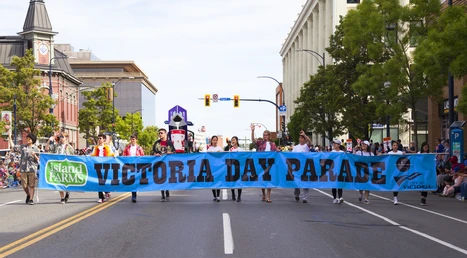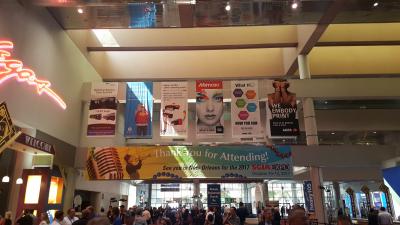Parade Banners

Parade banners are common in the United States. Properly designed banners at parades are essential in improving the undertaking of a targeted campaign.
It is notable that the minimum width of banners is usually 6 feet, while its length is slightly over 2.5 feet (Himes, 2016). In almost all cases, parade banners are easy to carry for long periods because they are not heavy. Fabric is the most common material that is used to make these banners, although vinyl is also suitable. Among the two, fabric banners are durable while vinyl ones are used for short-term purposes. Vinyl banners are therefore said to be cost-effective compared to fabric ones. Parade banners are useful in many aspects across the US.
Uses of Banners at Parades
Banners perform the task of passing information to a given targeted group during parade functions. As such, banners play crucial roles in parades, mostly in the US. Notably, the banners play the role of exciting attending crowds during a particular parade. Also, the banners are decisive in marking the start and end of a given procession. In the assessment of Hussain, Sweeney & Mort (2010), parade banners are displayed before parade floats, parade loyalties, and marching bands. It is observed that different types of banners have distinct functions during respective parades. Trade union banners, sports banners, advertising banners, campaign banners, advocacy banners, and wedding banners are examples of banners that are frequently used in parades. Notably, the roles of the listed parade banners have diverse roles and use. Allstate banners provide you with the opportunity of getting any of these banners, and any other banner that you may want, anytime and anywhere.
Trade union banners
Trade Unionists in the US resort to the use of banners to air their grievances. In notable cases, these types of banners are paraded by workers with the aim of advocating for better pay and improved working conditions. It is essential that trade union banners are painted in bright colors with the intention of conveying information over a large geographical area. Trade union banners can be made from canvas or cotton and painted in bright colors as earlier stated. In the US, trade union banners are majorly paraded during events that mark Labor Day celebrations (Pitch & Linden, 2014). These types of banners are also carried during demonstrations and go-slows by workers in protest over poor pay and in passing any other important message to the department of labor.
Sports Banners
Sports banners are often paraded and displayed in the stands of sports stadia. It is typical that a team’s banner would contain its name or nickname, team logo, team colors, and the motto of the team. It is also noted that there are banners of individual competitors. Banners of this type contain a drawing or picture of the participant. In view of Steenburg (2012), sports banners are remarkable in honoring prominent participants, while commemorating past performers and champions. In most cases, fans display and parade sports banners at the start of sporting events.
Advertising Banners
Advertising banners have largely evolved in many aspects. Most advertising banners are usually fabricated on a plastic background, and printed in large and wide formats to easily attract customers. Ultraviolet curable and solvent inks are particularly used to design these banners (Steenburg, 2012). It is notable that advertising banners are paraded across many business ventures in the US. Commonly, a group of individuals is identified and given the banners with the aim of parading them. It is common for such people to often move around from one point to another in a bid to reach out to targeted customers.
Political Campaign Banners
Political campaign banners are usually paraded by supporters of politicians during election periods. Notably, placards are designed and given to supporters who display them during campaigns. In the US, campaign banners play critical roles in enhancing the popularity of given politicians belonging to specific political parties (Manchanda, Dube, Goh & Chintagunta (2006). It is observed that campaign banners are designed to display the respective colors and slogans of particular political parties. It is therefore no doubt that campaign banners are crucial in drumming support for politicians in the United States. Political campaign banners are synonymous with political meetings that are usually held in conference halls and stadiums.
Advocacy Banners
Multiple organizations resort to the use of banners in advocating for given issues. It is notable that there are various advocacy campaigns that have resorted to the use of banners to reach out to the public. Some of these campaigns include; autism, HIV/AIDS, cancer, drug abuse, breastfeeding, and violence, among others. According to Himes (2016), participants of advocacy campaigns prefer the use of banners, while parading in order to pass out their message. Those who take part in the advocacies often parade their banners in major streets across the United States. Notably, all advocacy banners are associated with unique colors with respect to distinct advocacies.
Wedding Banners
Weddings are regarded as significant undertakings for the participants. It is therefore important for marrying couples to resort to the use of banners to make such days memorable. In other instances, couples resort to the use of engagement banners to announce their unions. Usually, wedding banners are paraded at church venues or other suitable places where particular weddings are scheduled to take place (Pitch & Linden, 2014). Vinyl is the best material for use when making wedding banners. It is observed that vinyl banners can either be used indoors or outdoors. Customized colors are applied to particular banners, after which a preferred text is written on them with the aim of passing an intended message. “Newly married” is one common phrase that best suits wedding banners.
Selecting Parade Banners
Selecting well-designed parade banners is decisive in achieving the intended purpose. With new technological advancements, new innovative measures are being incorporated in designing banners. Owing to this, there are improved structural properties and better quality products that are eye-catching in terms of aesthetics. The diversification of banners, therefore, presents difficulties in choosing the right product for prospective clients. The material specification for parade banners is influenced by a number of factors. According to Hussain & Sweeney (2010), these factors include purpose, printability, durability, installation, and cost, among others.
The purpose of a given parade banner is monumental when selecting a sample. It is important for the client to state his/her objectives for better delivery of the intended end product. When it comes to printability, it is wise for customers to select materials that display quality once printed. The choice of a particular material can have a big impact on a given banner. The interaction of ink and the selected material is crucial in producing the end product ((Manchanda, Dube, Goh & Chintagunta, 2006). The durability of parade banners is manifested in a number of elements ranging from weather elements and human contact. The weather elements that are likely to interfere with banners include the sun, wind, temperature, rain, and humidity. It is essential for customers to select durable banners since they would last long.
The installation of banners is another consideration that is taken into consideration. The simplicity and quickness of installation given banners play critical roles in determining their selection. However, most parade banners do not require installation given that they are usually carried with hands, during parades. More often, double-sided banners are used so that they capture the attention of passersby from both directions (Steenburg, 2012). Finally, the cost of parade banners is critical when making choices on the type to buy. Whereas individuals make key considerations in relation to aesthetics and performance, there should be a balance in the cost of such banners.
Conclusion
It is established that parade banners are common in the United States. Notably, the banners play significant roles in passing information to the intended audience. Owing to their lightweight, parade banners are easy to carry over long distances. Most commonly, fabric and vinyl are the major materials that are used in making banners. However, in other instances, the mesh is used as well. It is notable that parade banners have different roles and tasks depending on their nature. As highlighted in the discussion, various banners perform distinct functions at parades in the US. Some of the highlighted parade banners are trade union banners, sports banners, advertising banners, political campaign banners, advocacy banners, and wedding banners.
While making choices for the different types of parade banners, it is important for customers to make special considerations in relation to factors that affect their selection. As discussed above, the factors that customers are required to consider include; purpose, printability, durability, installation, and cost. The purpose of particular parade banners must be clearly identified when making selections. It is also important to choose materials that display quality after printouts. Durability, installation, and cost are also crucial in determining the type of banner to select. In conclusion, all of the above specified parade banners are available at Bannerstore.com. In identifying banner products and making inquiries, visit Bannerstore.com
Did you find it helpful?
LIKE
DISLIKE























Comments